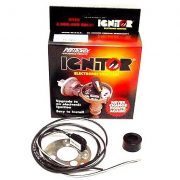When you read the word “Bakelite,” what does that bring to mind? Bright and colorful vintage jewelry? Grandma’s old plates from the ‘20s? Auto parts?
Bakelite was invented in 1907 by a Belgian chemist named Leo Hendrik Baekeland. Side note: Baekeland is also credited with the invention of Velox photo paper, which was the first commercially successful photo paper that could be processed under artificial light. Baekeland sold his company and the rights for Velox paper to American inventor George Eastman (Yes, THAT George Eastman, of Eastman-Kodak) in 1899.
Back to Bakelite:
How did it all start? Baekeland had told a friend that he joined the industry for money. His first project was to create a viable replacement for shellac, which had been made from beetle shells. By this point, scientists had realized that the natural resins and fibers that would be most useful in manufacturing and clothing were polymers. Baekeland’s wheels started turning.
Scientists were still unsure of how exactly polymers were constructed. They began throwing formulas at the wall to see if they could find a winning combination for a synthetic polymer, testing formulas as they went. While this was happening, Baekeland noticed something: he could mix phenol (a toxic, colorless or light pink crystalline solid) with formaldehyde to create a synthetic shellac. He called this “Novolak” which was never successful. After toying with the formula and doing some thinking, he decided to try something else.
Something Else?
Baekeland shifted to creating a binding agent instead. He tried the binder with asbestos, which had primarily been used with rubber, and found that his mixture—when the pressure and temperature were carefully controlled and monitored—created a relatively durable, moldable plastic that stood up to chemical, heat, and electrical action. This became very popular in radio, electric, and auto industries. The very special thing about this plastic, named Bakelite for its inventor, was that it was thermosetting. This means that you could not reshape it by heating it, and it did not conduct electricity. Despite all of its benefits, Bakelite was relatively expensive, heavy, and nonflexible.
As time wore on, materials and processes improved. Lighter, cheaper plastics that involved less serious chemicals and had more durability became the norm. By the 1940s Bakelite had just about lived out its production. Baekeland retired and sold his company in 1939 to what would become a subsidiary of the Dow Chemical Company. Nowadays, you can count the companies that produce similar phenolic resins on one hand. Still, Baekeland and his company set the stage for modern plastics which have shaped a large chunk of manufacturing and industry processes. Unfortunately, due to the drop in availability, the auto industry (including us) has been having a hard time finding some restoration parts in Bakelite.
Today, vintage Bakelite is a collector’s item. Some love to collect the vibrant resin jewelry of the ‘20s, and if you find the right collector it can fetch a fair price. Do you have any vintage Bakelite? Post a comment, or show us on Facebook and Instagram!







 Looking for our 2022 catalog? You’re in luck! The
Looking for our 2022 catalog? You’re in luck! The 

